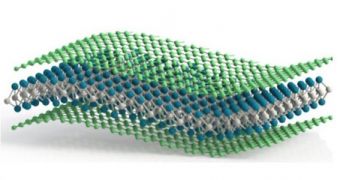Sodium-ion batteries could potentially outperform lithium-ion ones, some researchers say, but only if a series of issues are handled first. Chief among them is the fact that the negative electrode of sodium-ion batteries tends to swell to 4 or 5 times its original size, leading to mechanical damage.
One potential way to deal with this problem is to use graphene, the 2D hexagonal pure carbon lattice that is only one atom thick. This material has tremendous physical and chemical properties, including an extreme toughness and resilience to damage, IEEE Spectrum reports.
In a new study, investigators from the Kansas State University have demonstrated a new composite material, similar in structure and thickness with paper, which can improve negative electrodes. The material is made out of graphene and molybdenum disulfide. Details of its properties were published in the latest issue of the journal ACS Nano.
“The interleaved and porous structure of the paper electrode offers smooth channels for sodium to diffuse in and out as the cell is charged and discharged quickly. This design also eliminates the polymeric binders and copper current collector foil used in a traditional battery electrode,” says KSU assistant professor Gurpreet Singh.

 14 DAY TRIAL //
14 DAY TRIAL //